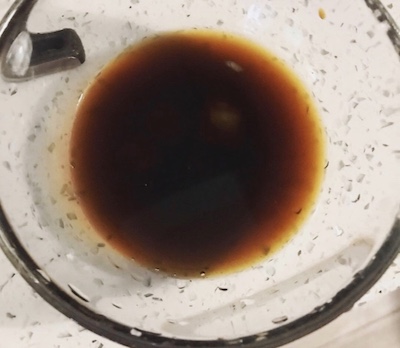We are reader supported. When you purchase through links on our site, we may earn an affiliate commission. Also, as an Amazon affiliate, we earn from qualifying purchases.
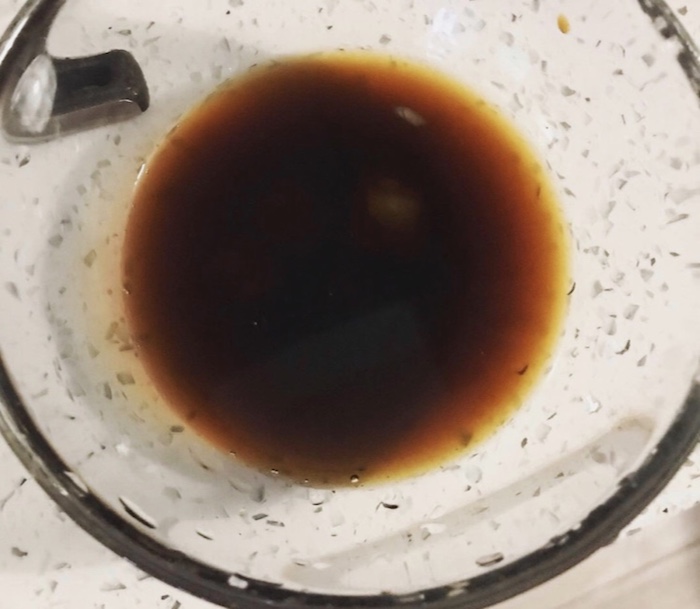
Have you ever wondered what makes Japanese cuisine so delicious that you can’t help licking the spoons and plate (you’ve been taught table manners since kindergarten!). Sushi is just awesome, no doubt about that but they are the sauces, marinades, and glaze that make the dish to die for.
The various soy-based mixtures may appear the same to a sushi beginner, but there are slight differences that bring about such fantastic flavors. In this post, I will talk about teriyaki sauce and glaze, the two essential Japanese condiments that are capable of breathing life into any ordinary dish.
Teriyaki sauce is the sweet and tangy mixture that can be prepared at home using 4-5 easily available ingredients – soy sauce, mirin, sugar, garlic, and ginger. It is sweeter than traditional soy sauce and the prominent notes of ginger and garlic make it a perfect addition to meat and fish.
The Teriyaki sauce may be used as a quick marinade to grill or bake fish or seafood used in sushi and other dishes. The glaze, on the other hand, is formed by thickening the sauce so that it turns into a shiny concoction that can be brushed on cooked or raw meat to enhance the flavor.
Contents
Difference Between Teriyaki Sauce And Glaze
Since I started making sushi at home, I prefer to have an arsenal of homemade sauces that can be used as a savior when I am craving for restaurant-style rolls at home. Even if I don’t have my favorite sushi fillings, a drizzle of the Teriyaki sauce and a little glaze on the top is all I need to enjoy fine dining without spending like crazy.
While there are many good brands of Teriyaki sauces you can buy from Amazon if you don’t have the time to prepare one, I prefer making my own sauces. It gives me the pleasure and the opportunity to boast in front of friends! So, when I prepare teriyaki sauce, I also set aside some for the glaze because it not only boosts the flavors but also adds a glossy effect to my dishes.
I will be sharing recipes for those who are interested in preparing teriyaki sauce and glaze at home, but before that let’s take a look at the few aspects that differentiate the two. If you are a sushi beginner, enthusiastic about learning the art of cooking sushi, knowledge about the sauces can make you a better cook.
Difference in uses
Both the teriyaki sauce and glaze are used for the same purpose – to flavor the fish, meat, or vegetables but the biggest difference lies in the way they are used. The sauce is used to cook fish, seafood or meat. It can be basted over the meat while grilling or stir-frying both sides.
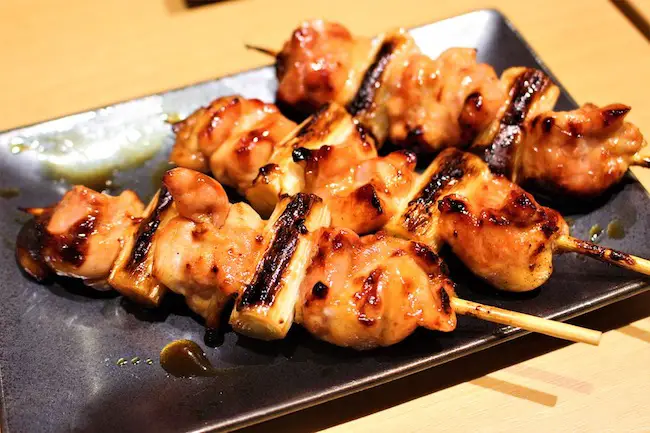
The sauce may also be used as a marinade and the meat is allowed to soak in the mixture for 20-30 minutes before it’s cooked (for fish 15 minute is enough). The sauce also serves as a table-side condiment that can be drizzled over sushi rolls and other dishes to enhance the flavor.
The teriyaki glaze is typically used to brush the toppings such as the fish part in nigirizushi or the rice part or toppings in uramaki (inside-out sushi rolls) Besides enhancing the flavor, the shiny effect of the glaze also makes the dish look more presentable.
Difference in texture
Based on the different uses, the texture of teriyaki sauce and glaze also varies a lot. The teriyaki sauce is thin and has a water-like consistency to allow the meat, fish, seafood, and vegetable to absorb the liquid when cooked or used as a marinade.
When used as a marinade, some people may prefer to add finely chopped scallions or chives to further enhance the flavor. When making your own teriyaki sauce at home, you may choose to keep it thin or slightly thick as per your preference.
The teriyaki glaze will always have a thick texture, viscous like glue. It should be able to flow easily out of the bottle, but thick enough to sit as a shiny coat over the toppings in sushi. It can also be used to flavor up the grilled or cooked seafood before adding them as fillings inside the roll.
Difference in flavor
The teriyaki sauce and glaze are made of the same ingredients so the signature taste is the same in both, but their flavor profiles may vary slightly. When the teriyaki sauces are used in a marinade or pan-fried with meat or fish, the flavor is strongly felt in the food.
The glaze, on the other hand, is only brushed on the top and it holds more of the presentation aspect in sushi. Although intense in flavor due to thickening of the sauce, you can only feel it for a few moments. The glaze does not permeate through toppings or ingredients, so the effect is short-lived.
If you are seeking a full-bodied flavor of teriyaki, use a thicker sauce to marinate the meat, fish or seafood. The different types of sauce available in the grocery stores may be ready-to-serve, mild, or full-bodied with a pleasing taste.
Recipe For Teriyaki Sauce And Glaze
Now, that you know the difference between teriyaki sauce and glaze, here are the step-by-step instructions to make your own concoctions at home. They can be stored in the refrigerator for several days and serve as a quick way to make a delicious meal anytime.
What you will need:
- 150 ml of soy sauce
- Fresh ginger
- 1 clove of garlic
- 1 tsp sesame seed oil
- 2 tsp olive oil
- 2 tsp olive oil
- 50 grams of brown sugar
- 150 ml mirin
- Toasted sesame seeds
Instructions
Take a small piece of fresh ginger, peel the skin and grate it (remember to use a little ginger as the taste can easily overpower other ingredients). Similarly, take a small clove of garlic and finely chop into small pieces. If you don’t want the ginger or garlic aroma to be prominent, avoid the grating/ chopping them.
Place a medium-size pan on the gas stove and heat 1 tsp sesame oil and 2 tsp olive oil. When the oil becomes hot, add the ginger and garlic. Simmer until they turn lightly brown and start releasing their flavor.
Now, add brown sugar and stir for a few seconds to allow it to caramelize. Be careful at this point so as to not burn the sugar.
When the sugar starts forming lumps, add soy sauce and mirin. Some people also prefer to add a little sake at this point. Stir the solution to ensure that the solids dissolve completely.
When the sugar has dissolved completely, reduce the heat and let the mixture simmer for 15-20 minutes. Stir to make sure that the solution is evenly mixed.
Once the mixture achieves sauce-like consistency (depending on whether you want a thin or thick sauce), remove the heat and let it cool.
Steps To Make Teriyaki Glaze
To make a glaze, transfer half of the sauce to another bowl and let the remaining liquid simmer on medium heat. Keep stirring to prevent the sauce from sticking to the base.
Wait until the sauce thickens like glue and gets a visible sheen. Remove the pan from the heat before it turns too sticky. To make it more aesthetic, add a tablespoon of toasted sesame seeds to the mixture.
At this stage, the sauce has reduced considerably but it is still liquid-y. Remove the pan from heat and pour the thickened glaze into a glass bowl or jar.
Ways To Use Teriyaki Sauce And Glaze In Sushi
Although they are made of the same things, the methods to use teriyaki sauce and glaze vary widely in sushi and other Asian cuisines. While the sauce forms an integral part of the cooking process, the glaze is mostly used to highlight the food and enhance the flavor.
# Teriyaki Salmon And Avocado Sushi Roll
I agree that sushi-grade salmon tastes best with sushi, but if you don’t have one available, here’s a quick recipe to pan fry salmon with teriyaki sauce to make an awesome filling.
What you will need
- 2 cups of cooked and seasoned sushi rice
- Nori sheets
- Teriyaki Sauce
- Salmon fillets like this
- 1 tbsp vegetable oil
- 1 ripe but firm avocado, cut into slices
- 1 Japanese cucumber, cut into thin strips
Instructions
Cook sushi rice before you start preparing the fillings because rice takes longer to cook and cool before you can season it. I have created an article that explains how to cook sushi rice in a cooker and pot.
To make teriyaki salmon, place the salmon fillets and teriyaki sauce (enough to completely coat the fish) in a zip lock bag. Marinade for 15-20 minutes.
Put a large skillet on the gas stove and add 2 tablespoons of vegetable oil. Add the salmon fillets and cook on low heat. In a separate pan, put the marinade mixture and add cornstarch mixed in water to thicken the sauce. Simmer until it thickens well.
When the salmon is fried on both sides, drizzle the thickened teriyaki sauce and let it cook for another 5 minutes or until the liquid evaporates. Transfer to a paper towel to remove excess oil and sauce. Cut the salmon into thick strips (preferably 1/2 inch) to be used in a sushi roll.
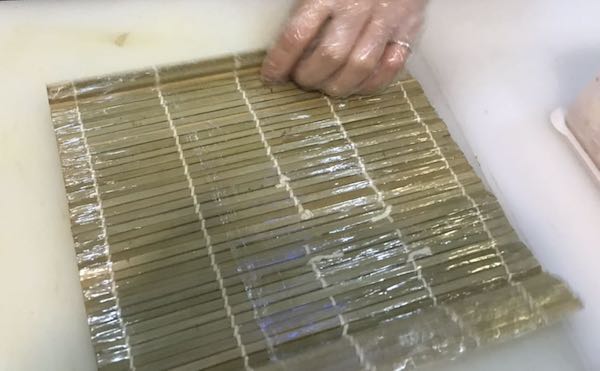
Place a bamboo mat on the kitchen table and cover it with a cling film. Put a nori sheet over the covered bamboo mat, shiny side facing down. Take half a cup of seasoned rice and spread over the seaweed, leaving a 1-inch gap on the side away from you.
Now, add the salmon strips, 2-3 avocado slices, and a few cucumber strips for crunchiness. Lift the bamboo mat from your side and start rolling. When you reach the other side, seal the edges by moistening the nori sheet.
Take a sharp Japanese knife and cut the sushi roll into 6-8 equal pieces. Serve with teriyaki sauce, wasabi, and pickled ginger.
# Sweet Potato Tempura Roll With Teriyaki Glaze
This is a delicious maki roll recipe that can be easily prepared and shows how to use teriyaki glaze to liven up any dish. Try this at home and your vegan friends will go crazy about your cooking skills.
What you will need:
- 2 cups of seasoned sushi rice
- Nori sheet
- Teriyaki glaze
- Vegetable or canola oil for frying
- 1 medium-sized sweet potato
- Ready-made tempura mix
- 1 Avocado, pit removed, peeled and cut into slices
- 1 Japanese cucumber cut into strips
Instructions
Start by cooking the short-grain rice as per the instructions mentioned in my article. When the rice cools, season it with vinegar, salt, and sugar.
Peel the sweet potato and cut it into finger-size strips. Now, mix the instant tempura batter in cold water to achieve the desired consistency.
Heat oil in a frying pan and when the oil becomes hot enough, dip the potato strips in the tempura batter and put them carefully in the oil. Fry until the potato strips turn golden and then transfer them in a paper towel.
Put the bamboo mat on the table and cover it with plastic. Keep the seaweed over the bamboo mat. Take half a cup of seasoned rice and make an even layer on the nori sheet, leaving about ½ inch gap on the top (away from you).
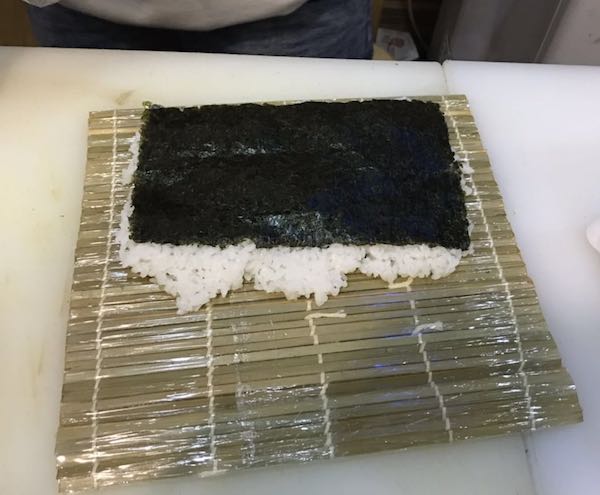
Gently press the rice to ensure that it sticks on to the seaweed. Now, flip the nori to have rice part facing downwards and nori towards you. Add strips of sweet potato tempura over the nori, towards the middle. Place a few cucumber strips on the side.
Lift the bamboo mat from your end and start rolling. Apply gentle pressure to ensure that the contents stay intact. Use the knife to lift the avocado slices and arrange them in a line to cover the top rice part of the sushi roll.
Cover the sushi roll with a plastic sheet and place the bamboo mat over it. Squeeze gently to make the avocado shape up with the rice. Use a sharp knife to cut the roll with the plastic on. Now, remove the plastic.
Finally, take a small brush and dip in the teriyaki glaze. Brush this thick and glossy concoction generously over the avocado toppings. When you eat the bite-size pieces of this delicious sweet potato tempura roll, the aroma and flavor of the teriyaki glaze is the first thing that will come in contact with your tastebuds. Enjoy
Related Questions
What does teriyaki mean in English?
Teriyaki is a Japanese word that refers to a cooking method. Teri means to shine or luster, and Yaki means broiled, grilled, or pan-fried. While the term is popularly used with ‘sauce’, it does not refer just the sauce but just about anything that is pan-fried or grilled with a glaze.
In what ways can I use the teriyaki sauce?
The teriyaki sauce can be used as a table condiment you can add to any dish to make them taste great. It can also be used as a marinade to breakdown the flesh and vegetables before cooking them. Another amazing use of the sauce is achieved by turning it into a glaze that you can brush on nigiri and rolls to make them look more appealing.
How long can homemade teriyaki sauce last?
If you keep the sauce in an airtight container and store inside the refrigerator, it can stay good for 2-3 weeks. Remember that the sauce will thicken further as it cools so adjust the thickness accordingly.
What does teriyaki sauce taste like?
It has a sweet and sour taste, inclined more on the salty-sweet side. The texture is slightly glue-like but still tangy. Imagine mixing soy sauce with honey. You get a sweet taste but the strong taste of soy sauce is also prominent.
How can I thicken teriyaki sauce if I am gluten-sensitive?
Use arrowroot instead of cornstarch if you are intolerant to gluten. Arrowroot has no flavor so it will thicken the sauce and make it glossy without altering the taste.
See Also:
Difference Between Chirashi And Donburi
Why Is Sushi So Expensive

